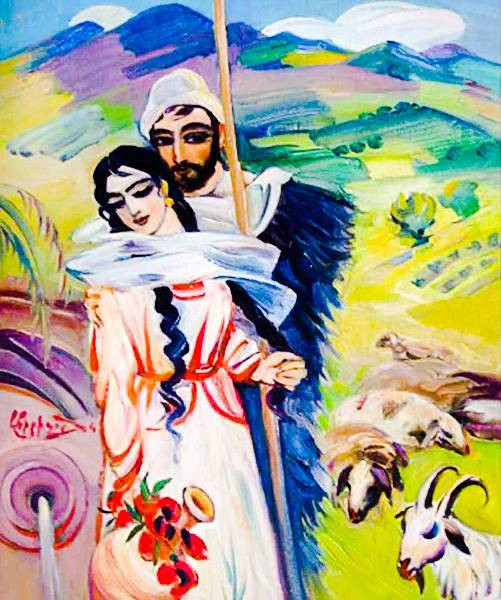Wrestling: 8 facts you didn’t know about Armenia’s favorite sport
August 05, 2019
Football (or “soccer” as it is called in the English-speaking New World) may be the most famous sport in the world, but not in Armenia. Though this foreign import is gaining traction amongst Armenians, the most popular —and successful—sport in Armenia has been and continues to be, wrestling. Kokh, the Armenian national variant, is deeply rooted in the historical and cultural landscape of the country.
Here are eight exciting facts about this combat sport that has captivated Armenians throughout the centuries.
Do you engage in this beloved Armenian pastime? Let us know in the comments!
1. Wrestling in Armenia is a really, really old tradition

The rugged terrain of the Armenian Highlands birthed a vibrant, creative people. Ancient Armenians engaged in a multitude of physically demanding sports, such as boxing, horse riding, and archery. Kokh is an ancient form of wrestling that has its origins in the Armenian Highlands and is believed to be at least 1,500 years old, thus making it one of the oldest forms of wrestling in the world. It may even predate Christianity, as the sport draws on several pagan themes and rituals, such as predicting the outcomes of future battles, the weather, and other significant events. As such, kokh became a crucial forecaster of honor or sin in ancient Armenia, and its significance is on par with more famous cultural customs, such as singing and dancing.
To see a traditional kokh ritual, complete with sheep herding, lavash baking, and village shurjpars (line dancing), check out this black and white Soviet-era video (in Russian, but still informative and entertaining). (Photo: Ancient kokh relief in Armenia, courtesy of allinnet.info)
2 . No wedding was complete without some (friendly) tackling

Kokh was a staple at ancient Armenian weddings: A fighter from both sides (the bride and groom) would wrestle each other during the festivities. Of course, Armenian weddings remain important places to meet new people, but in ancient times, they were also a key opportunity for each gender to “show off” their skills to attract potential suitors. For women, this included graceful naz dancing, while men wrestled and danced—sometimes both at the same time. (Painting: "Wedding in Hrazdan" by Sarkis Muradyan)
3. A festive kokh-gone-wrong propels the tragic love story in “Anoush”

The Armenian version of Romeo and Juliet is Anoush and Saro, the ill-fated lovers of Armen Tigranian’s opera (based on Hovhannes Toumanyan’s poem), titled “Anoush.” The first opera inspired by Armenian folk music and culture, Anoush opens with a typical 19th-century Armenian village wedding, featuring a ceremonial wrestling match between Saro and Mossy. The prevailing custom dictates that Saro allow Mossy to win. However, distracted by the beauty of Anoush (Mossy’s sister), Saro breaks with the local code of honor and pins his opponent to the ground. (Fast forward to 37:00 to watch the action unfold in this film adaptation of the beloved Armenian story.) This brings great shame and humiliation to both characters, thus launching the melancholy plot. The stylized kokh battle becomes the classic battle of lover against his beloved’s family and, as we know, star-crossed lovers rarely have happy endings.
The poem, Anoush, describes this battle prelude: [Translated by Beata Asmik Navratil] There was a wedding-feast one wintry night, The village multitude rejoiced unrestrained; There too, had descended the shepherds young, To look at the maidens, to dance and wrestle (kokh). (Painting: "Anoush and Saro" by Alexander Grigoryan)
4. Kokh is a dance

Wrestling in ancient Armenia came in many forms, such as pailevani khakher/parer (pailevan dance), a pantomimed style, and hand-on-hand fighting, called giulash kpnel. Kokh is based on this latter form, which was performed to the accompaniment of instrumental music, with a ceremonial warm-up dance. It is no surprise, then, that many refer to kokh as a “wrestling dance.” (Photo: panarmenian.net)
Preparing for the fight

Before the start of a fight, wrestlers shake hands as a sign of peace. Local villagers play music as the combatants dance in their respective circle, gradually moving towards one another, and high fiving with their arms above their heads (similar to the clapping of the martial folk dance, yarkhushta). They then grab each other by the waist and begin the fight, with the winner forcing the opponent’s shoulder/back to the ground. In this image from a 2016 kokh tournament in Armenia, the fighters are clapping, a distinctive feature of this “dance sport.” (Photo: sport.mediamax.am)
5 . And also an art form

In addition to serving ritualistic and premonitory purposes, kokh—perhaps most obviously—is also a great fighting technique. In fact, it was so effective as a sparring tactic that the Soviet combat martial art, sambo, drew heavy inspiration from it. Despite this, kokh fell out of usage, and by the late 1980s, was relegated to merely the most rural areas of Armenia. (Photo: hayernaysor.am)
Kokh on stamps

This 1963 Soviet stamp depicts kokh before its decline, which lasted several decades. Today, the new republic is experiencing a rejuvenation in the sport, mainly fueled by the government’s recent institutionalization of it. (Historically, kokh was simply passed down from elder to pupil in local village communities.) In 2001, the National Kokh Wrestling Federation (NKWF) opened, and—lin 2017 alone—the organization held several tournaments throughout Armenia, frequently cooperating with the Ministry of Culture to preserve all elements of this traditional art form. (Photo: kokh.info)
Cultural components

Similar to the Brazilian martial art of capoeira, kokh is not just about the physical strength/fighting component; it simply would not exist without the folk music, dance, and attire that make kokh a part of the rich cultural heritage of its people. As former Greco-Roman wrestling world champion and head of the NKWF, Vaghinak Galustyan, stated, “Kokh is not just a sport. It contains a cultural component and interesting ceremonies, as well. They should be revived, too.” (Photo: kokh.info)
6. One can wrestle either topless or in full traditional garb

Depending on which style of kokh you engage in, the outfit can drastically vary. There are two main varieties, named after different regions in Armenia: Shirak kokh and Lori kokh. The rules are nearly the same, save for a few key differences. In Shirak kokh, wrestlers fight topless and are allowed to grab the legs of the opponent. (Graphic : kokh.info)
Lori kokh

Contrary to many wrestling styles today, kokh focuses on slamming and throwing, rather than grappling. Today, most fights last about 5-10 minutes, and many contests require the winner to perform a traditional victory dance in front of everyone. In Lori kokh, fighters wear traditional robes and have to grab their opponent’s robe to throw them down. (Graphic: kokh.info)
7. Some kokh champions became kings

Though many sports players achieve “celebrity royalty” status, very few have actually gone on to become monarchs. In the 3rd and 4th centuries, the ancient Olympic games featured many Armenian athletes, a couple of whom went on to become kings. This ancient memorial plate depicts the 385 AD Olympic boxing champion, Varazdat, who later became King of Armenia. (Photo: The Armenian Weekly)
Athletic royalty

Many know King Tiridates III as the ruthless reformer who converted Armenia to Christianity, (making the Armenian kingdom the first state in the world to adopt the religion) but several decades prior, he was just your average prince…who happened to also be an Olympic champion. In 281 AD, Prince Tiridates became one of the first Armenian Olympians when he won the wrestling event at the 265th Olympic games. Really brings new meaning to the term, “athletic royalty,” doesn’t it? (Photo: alchetron.com)
8. Armenia is still wrestling royalty

This commemorative silver coin depicting kokh was released by the Central Bank of Armenia in 2012 and has come to symbolize the nation’s ever-growing fascination with wrestling. Though the Armenian variant of the sport may not enjoy the popularity it once did, other forms of wrestling—such as Greco-Roman and Freestyle—remain as cherished as ever. (Photo: azatutyun.am)
Hero's welcome

It is no exaggeration that this ancient phenomenon is as much a part of the Armenian legacy as lavash and duduk. So, no matter how successful our football team becomes, kokh will reign supreme in Armenia for centuries to come. Here, Olympians Mihran Harutyunyan and Artur Aleksanyan are given a hero’s welcome by fans upon their return to Armenia following their wins at the 2016 Rio Summer Olympics. (Photo: armnoc.am)
Maksim Manukyan

Wrestling is a lifestyle in Armenia, and this tradition has not faltered throughout the centuries, as Armenia remains one of the best wrestling nations in the world. Despite its small population, Armenia has produced countless talented and prodigious wrestlers, many of whom have gone on to global success, earning awards and breaking records. Over 50 percent of all Armenian Olympic and international sports medals have come from wrestling. Pictured here is Greco-Roman wrestler, Maksim Manukyan, who became world champion in his weight division in 2017. (Photo: Artur Aleksanyan/Facebook)
Artur Shahinyan

Just today, Greco-Roman wrestler Artur Shahinyan, won a gold medal in the Poland Open international wrestling tournament held in Warsaw, Poland. The competition was so stiff on Armenia’s end, that Shahinyan ended up competing against his compatriot, Maksim Manukyan, for the title! (Photo: panorama.am)
Want to learn more about the age-old Armenian pastime? Check out the video below for some more kokh action!
Video
Join our community and receive regular updates!
Join now!






Attention!